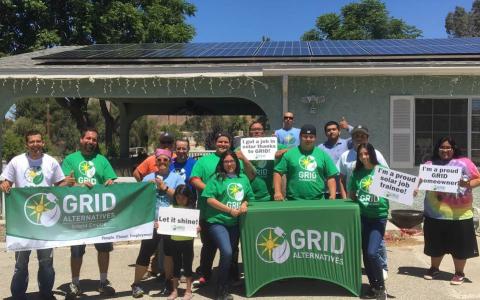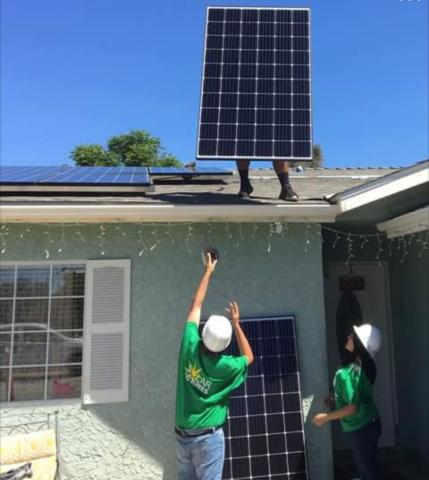Learning about solar power sparks future jobs ◆ By Mike Hiles
Seven Noli Indian High School students learned about sustainable energy through GRID Alternatives Inland Empire, a nonprofit solar contractor, and its innovative Solar Futures program. As part of teacher Jay Dagostino's environmental science and alternative energy class, students were given the information needed to install photovoltaic solar panels at two build sites on the Soboba Reservation.
Raymond Barsz, Gabriel Gomez, Steve Medina, Erika Modesto, Jesy Sigler, Sabrina Smestad and Gilbert Vallejo received certificates of participation when the semester-long project was completed.
Dagostino utilized materials from GRID and the Next Generation science standards to teach students about alternate energy sources, environmental resources, energy audits and natural resource management during the classroom portion of the course which began in January.
The elective course provided five hours a week of training, both at Soboba Reservation school and in the field.
"They did well," said Dagostino, who has taught at Noli for five years. "I'm proud of them for taking it seriously."
Homeowner Johnna Valdez had considered converting to solar energy for a few years and contacted GRID in February as an affordable alternative to other estimates she had received in the past.
"After finding out this was a joint project with GRID and Noli, I was willing to help the students for their hands-on training," Valdez said. "Watching the students install was great. You would never know they were beginners – they got up there like a pro."
After talking with Lisa Castilone, GRID Alternatives Outreach and IE Tribal Manager, Valdez learned the students needed to provide installation on two homes to complete their assigned training.
"I contacted (Soboba Reservation resident) Pamela Valdez Miranda and explained the project to her and she agreed to accept the project installation on her home," Valdez said.
She said once the paperwork was completed, it only took two days for the installation of the solar panels and to have the system up and running. Prior to installation, an engineer visited the homes to draw up plans as to where the panels would be positioned.
"Positioning is the key because you want your panels to generate as much energy as they can," said Valdez, who hopes to see a difference in her energy bill within the next few months.
The Solar Futures program provides both classroom and hands-on solar education to students in grades kindergarten through community college, with a focus on high school juniors and seniors ready to enter the workforce.
Students are exposed to a wide variety of career opportunities within solar, an industry which has experienced 15 to 20 percent growth during the past several years. Noli students represent several different tribes, although six of the seven who participated in the recently completed project are from the Soboba Band of Luiseño Indians.
"We were very excited to launch a partnership with the Soboba tribe in San Jacinto," said GRID Alternatives Regional Director Bambi Tran. "GRID currently works with 40 Native American tribes across the United States and it's through collaborations like the one we have with Soboba that we're able to include everyone in the transition to clean, renewable energy."
Senior Jesy Sigler, a member of the La Jolla Band of Luiseño Indians, had some prior knowledge of the power of solar before taking on this project.
"My dad had worked at the San Onofre nuclear power plant during its construction," said Jesy, 18. "I was curious to find out more about solar energy because this could be a big business in the future and the pay is good. I enjoyed doing something hands-on and it was good work experience to have under my belt."
Senior Steve Medina, 18, is thinking about becoming a volunteer with GRID Alternatives to further his experience with installation and the industry in general.
Raymond Barsz said installing the panels was his favorite part and wants to continue to work in this field after he graduates this year.
"It was way different in the classroom where we learned about AC/DC converters and how everything is combined – it was pretty cool," said Raymond, 18.
The lightweight photovoltaic panels did not pose a challenge for senior Sabrina Smestad.
"I liked doing the hands-on work instead of just sitting in the classroom and listening," said Sabrina, 18. "It was a great experience to see the whole installation from start to finish."
Freshman Erika Modesto felt like she learned more about how things work through the time spent in the field.
"I also learned about how beneficial solar energy panels are," she said.
Dagostino said he appreciated the opportunity to offer something different to the students.
"Any sort of applied learning is great," he said. "It was a great chance for the students to get out of the classroom to learn real life experiences. It was good for those that didn't thrive in the classroom. By the second build they were all doing what they had been taught."
He said a few logistical issues, such as coordinating the field work with other school activities, provided a few challenges. Funding sources for the clean energy projects included the SASH (Single-family Affordable Solar Homes) program administered through GRID, a fee for service from the Noli Indian School and donations from the homeowners.
"We always say the children are our future so I'm glad Noli took on this project that gave the students classroom and hands-on training," Valdez said. "I hope this project continues at Noli or just within the tribe."
Noli Indian School Principal Donovan Post said he was proud to have entered into a working partnership with the nonprofit.
"GRID Alternatives has been on our campus working with our students, teaching them all about how to work with, install and maintain solar on homes," Post said. "We hope that they can take this interest and turn it into a wonderful career."
Information, www.gridalternatives.org





